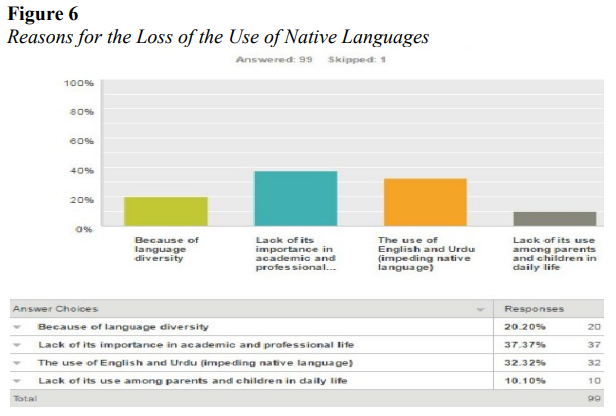Impact of Multilingualism on Shina Language in Urban Setting: Issues of Language Shift among Youth
Abstract
 Abstract Views: 0
Abstract Views: 0
The present study explores the impact of multilingualism on the Shina language in urban settings and examines issues related to language shift among native speakers of Shina. The sample consists of one hundred urban educated Shina speakers, aged 18 25 years, of both genders, who are studying at universities in Rawalpindi/Islamabad. The study adopts a mixed-method approach, utilizing both quantitative and qualitative methods. Data were collected through a questionnaire and group discussions. The domains used to design the questionnaire and group discussions are based on Sabiha Mansoor’s (1993) 'Punjabi, Urdu, and English in Pakistan: A Sociolinguistic Study'. Shina, an important language spoken in Gilgit-Baltistan, is endangered due to its speakers' social and economic need to learn English and Urdu for education and employment. The findings reveal that Shina is rarely spoken in the domains of interactions with strangers, social gatherings, and communication with teachers, with the exception of the home domain, where it is spoken by 81% of the respondents. The respondents exhibit negative attitudes toward Shina and positive attitudes toward English and Urdu. In urban settings, where a diverse range of languages coexist, languages inevitably influence each other—a phenomenon also observed in the case of Shina.
Downloads
References
References
Anjum, U. (2016). Language shift and the speech community: A
sociolinguistics study of Tarawara community in Bandi Shungli
[Doctoral dissertation, National University of Modern Languages,
Islamabad, Pakistan]. DSpace JSPUI.
http://repository.pastic.gov.pk/jspui/handle/123456789/4188
Baker, C. (1988). Key issues in bilingualism and bilingual education (Vol.
. Multilingual Matters.
Berman, R., Lefever, S., & Woźniczka, A. K. (2011, September 30).
Attitudes towards languages and cultures of young Polish adolescents
in Iceland [Paper presentation]. Netla – Menntakvika 2011 School of
Education, University of Iceland, Reykjavik, Iceland.
Chana, U., & Romaine, S. (1984). Evaluative reactions to Panjabi/English
code‐switching. Journal of Multilingual & Multicultural
Development, 5(6), 447–473.
https://doi.org/10.1080/01434632.1984.9994174
Coupland, N., & Jaworski, A. (1997). Relevance, accommodation and
conversation: Modeling the social dimension of communication.
Multilingua, 16(2–3), 233–258.
https://doi.org/10.1515/mult.1997.16.2-3.233
Fishman, J. A. (1964). Language maintenance and language shift as a field
of inquiry. A definition of the field and suggestions for its further development. Linguistics, 2(9), 32–70.
https://doi.org/10.1515/ling.1964.2.9.32
Franceschini, R. (2011). Multilingualism and multicompetence: A
conceptual view. The Modern Language Journal, 95(3), 344–355.
https://doi.org/10.1111/j.1540-4781.2011.01202.x
Fromkin, V., Rodman, R., & Hyams, N. (1999). An Introduction to
Language. Southwood Press.
Gordon, G. R. (2005). Ethnologue, languages of the world. SIL
International.
Ianos, A. (2014). Language attitudes in a multilingual and multicultural
context. The case of autochthonous and immigrant students in
Catalonia [Doctoral dissertation, Universitat de Lleida]. Dialnet.
https://dialnet.unirioja.es/servlet/dctes?codigo=87343
Jenkins, J. (2008). English as a lingua franca: Attitude and identity. Oxford
University Press
Kießling, R., & Mous, M. (2004). Urban youth languages in Africa.
Anthropological Linguistics, 46(3), 303–341.
Mansoor, S. (1993). Punjabi, Urdu, English in Pakistan: A sociolinguistic
study. Vaguard Books Pvt Ltd.
Nettle, D., & Romaine, S. (2000). Vanishing voices: The extinction of the
world's languages. Oxford University Press.
Noguchi, M. G., & Fotos, S. (Eds.). (2001). Studies in Japanese
Bilingualism (Vol. 22). Multilingual Matters.
Rahman, T. (2002). Language, power and ideology. Economic and Political
Weekly, 37(44/45), 4556–4560.
Rahman, T. (2003). Language policy, language death and vitality in
Pakistan. In A. Saxena & L. Borin (Eds.), Trends in linguistics studies
and monographs (pp. 73–104). De Gruyter Mouton.
Riaz, F. (2011). Punjabi Language: A study of language
desertion [Doctoral dissertation, National University of Modern
Languages]. DSpace JSPUI.
http://repository.pastic.gov.pk/jspui/handle/123456789/3488
Sharp, D., Thomas, B., Price, E., Francis, G., & Davies, I. (1973). Attitudes
to Welsh and English in the schools of Wales. Macmillan Education.
Trask, R. L. (1995). Origins and relatives of the Basque language: Review
of the evidence. In J. I. Haulde, J. A. Lakarra, & R. L. Trask (Eds.),
Towards a history of the Basque language (pp. 65–100). John
Benjamins Publishing Company.
Valdés, G. (2005). Bilingualism, heritage language learners, and SLA
research: Opportunities lost or seized? The Modern Language
Journal, 89(3), 410–426. https://doi.org/10.1111/j.1540-
2005.00314.x
Veltman, C. (1983). Anglicization in the United States: Language
environment and language practice of American adolescents.
International Journal of the Sociology of Language, 1983(44), 99–114.

Copyright (c) 2025 Yasmin Akhtar, Maria Bibi, Nishat Tarnum

This work is licensed under a Creative Commons Attribution 4.0 International License.

This work is licensed under a Creative Commons Attribution 4.0 International License. Authors retain copyright and grant the journal right of first publication with the work simultaneously licensed under a Creative Commons Attribution (CC-BY) 4.0 License that allows others to share the work with an acknowledgement of the work’s authorship and initial publication in this journal.







